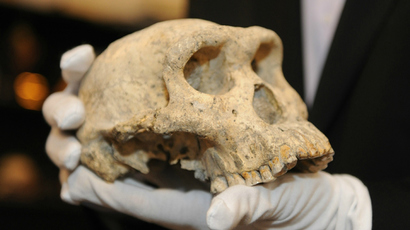13,000 yo skeleton sheds light on Native American origins

Divers have uncovered what they think is the oldest skeleton in the Americas, which dates back 13,000 years and belongs to a teenage Mexican girl. The DNA is very ancient, older than the east-Asian ancestors of ancient Native Americans.
The study, led by the Mexican government's National Institute of
Anthropology and History (INAH) with support from the National
Geographic Society, was published in the journal Science on Friday.
The 15-16 year old Naia, as the scientists called her, was
probably searching for water when she plunged to her death into
an underground cave system during the last Ice Age. The place is
ominously known as the ‘Hoyo Negro’ – the Black Hole – and is
located in the Yucatan Peninsula in southeastern Mexico.
There is nearly zero topographical difference between the layout 13,000 years ago and now, only that water now dominates the entire cave network. But that is exactly what allowed the skull to be preserved in such pristine condition, and for the team to extract a lot of meaningful information from Naia’s DNA. The skull and the nearly complete skeleton lay unmoved, 40 meters below sea level, next to a variety of animals that once roamed the area – some of them extremely exotic ancestors of today’s creatures.
Naia gives scientists the "opportunity to help answer the question of Paleoamerican origins," paleontologist James Chatters, an author of the analysis which was published in the journal Science, told reporters this week. Her final resting place, "sealed off by water and darkness for more than 8,000 years, is a time capsule … of Central America at the end of the Ice Age."
Scientists named her Naia after a water nymph from Greek mythology. The slight, adolescent girl was approximately 4 feet, 10 inches tall at the time of her death.
One of the divers, Alberto Nava, recalls the moment when her skull was first discovered resting on top of a small ledge: “It was a small cranium laying upside down with a perfect set of teeth and dark eye sockets looking back at us,” Nava said.
There are two types of Native-Americans – the modern ones, and the ancient race, who arrived from northeast Asia 15,000-20,000 years ago. When it comes to looks, they share few features in common. While one may think of the modern branch as resembling the peoples of China, Korea or Japan, the older one’s individuals bore a much deeper resemblance to the peoples of Africa, Australia and the general South Pacific region. Their faces are generally narrower and forward projecting.
This offers up an interesting migration hypothesis – that the American continent was not colonized by separate migration events from various parts of Eurasia. Both the shape of Naia’s skull and her DNA indicate that there was only one major migration to the Americas, which took place when the Bering Strait was basically all traversable land.
Scientists say the news study has solved “the problem” of the varying features of the Paleoamericans vs. modern-day Native Americans. But the discovery of the once-in-a-blue-moon skeleton also raises other questions about human adaptation, Rasmus Nielsen, a geneticist at the University of California, Berkeley, told USA today.
“Of course, it's interesting, because it raises a new question: Why are there (skull and facial) changes? Is it really true that Native Americans have evolved … in such a short amount of time?"
Chatters says that other human populations have evolved over similarly short time frames. A more thorough genetic of analysis of Naia is in the works to discover what other secrets can be gleaned from her bones.














